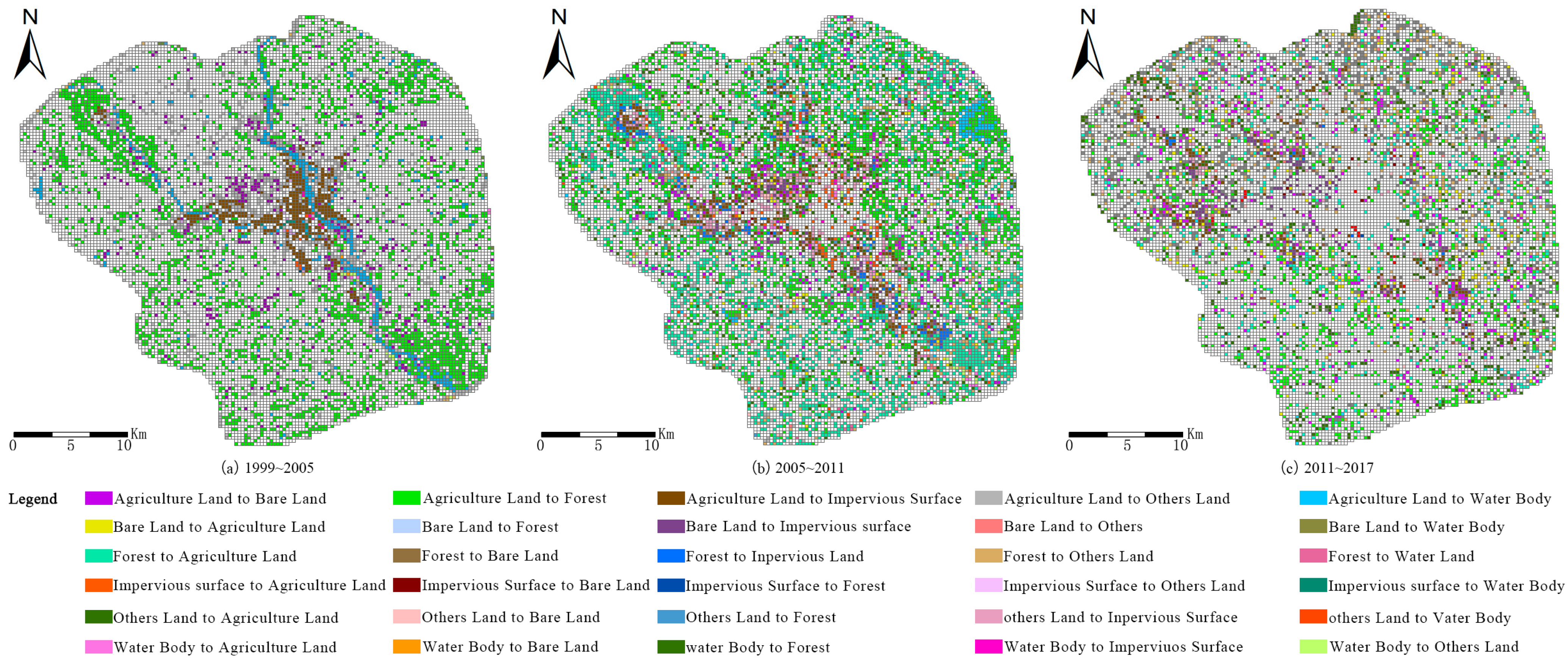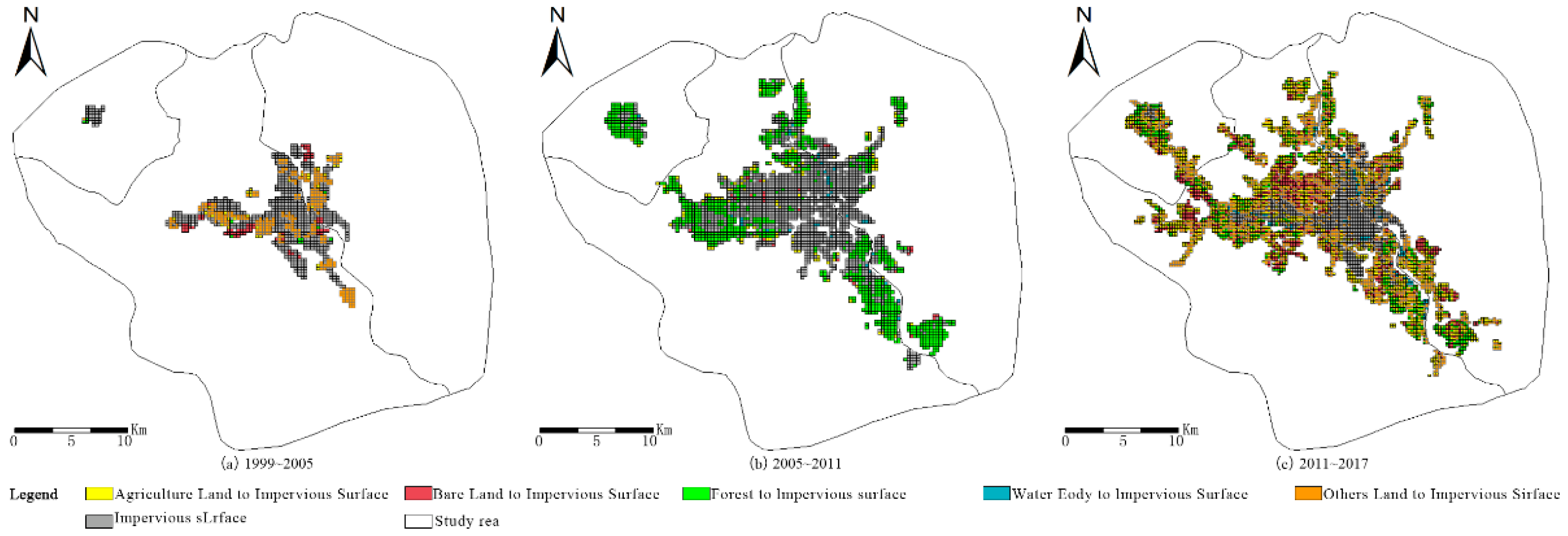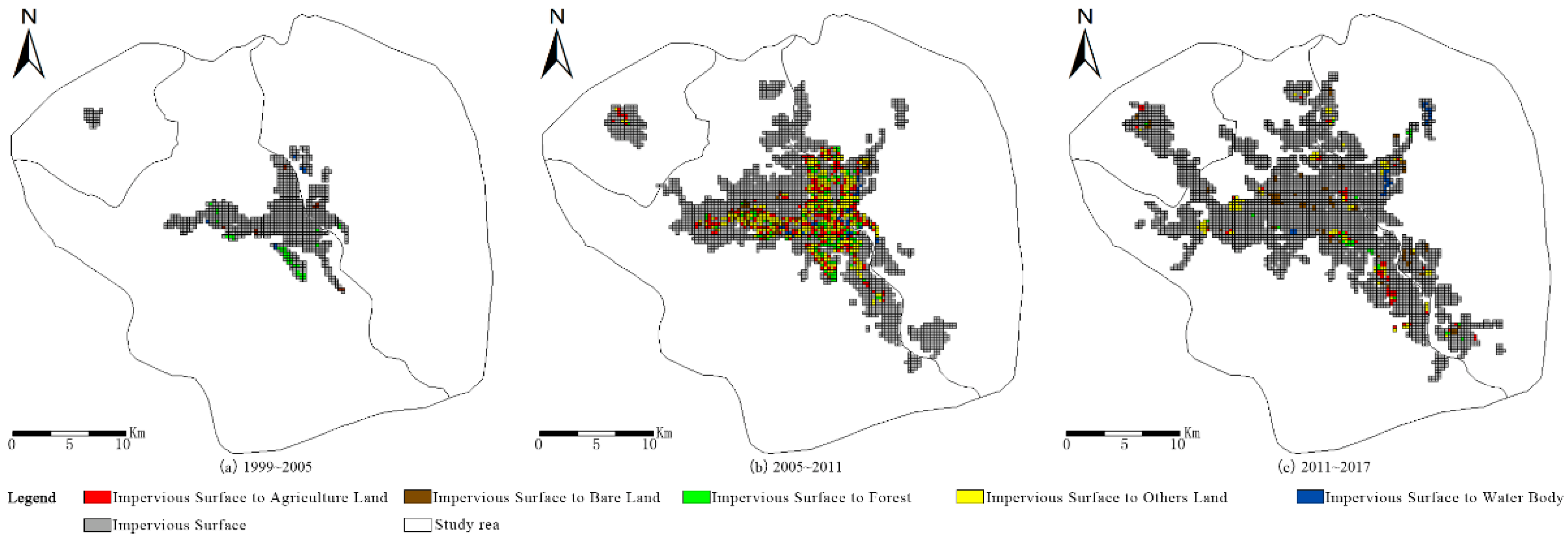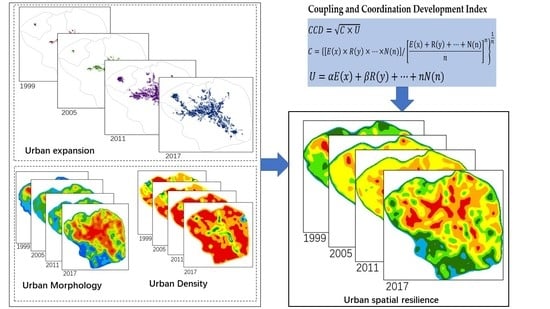Coordination Conflicts between Urban Resilience and Urban Land Evolution in Chinese Hilly City of Mianyang
Abstract
:1. Introduction
2. Literature Review
3. Research Design
3.1. Dynamic Analysis of Urban Resilience Based on LULC Change
3.1.1. Urban Morphology Resilience
3.1.2. Urban Density Resilience
- (1)
- Rasterize the surface of the study area indicating both “source” and “sink” patches employing a consistent grids.
- (2)
- Calculate the distance from each grid inside a certain “source” patch to the nearest grid inside the nearest “sink” patch. The greater the adjacency of “source” and “sink” patches. The more resilient the urban condition vice versa, if the “source” patch and the “sink” patch are severely separated in space, the possibility of offsetting the negative effects is significatantly reduced resulting in a lower resilience in the urban condition.
- (3)
- Through the standardized operation of negative indicators, the urban density resilience index can be obtained. The higher the index value, the higher the urban density and resilience. Conversely, the lower the index value, the lower the urban density and resilience.
3.2. Coupling and Coordination Development Index
4. Study Area and Data Processing
4.1. Study Area
4.2. LULC Remote Sensing Interpretation Method
5. Results
5.1. LULC Variation Characteristics
5.1.1. Changes of Direction and Intensity
5.1.2. Land Conversion of Different LULC
5.1.3. Expansion and Transpose of Urban Impervious Surface
5.2. Dynamic Evolution of Urban Resilience
5.2.1. Urban Morphology Resilience
5.2.2. Urban Density Resilience
5.3. Coordination Analysis of Urban Resilience and LULC
6. Discussions
6.1. Morphological and Density Characteristics of Urban Resilience
6.2. Coupling Relationships between Urban Expansion and the Urban Resilience
7. Conclusions
Author Contributions
Funding
Institutional Review Board Statement
Informed Consent Statement
Data Availability Statement
Conflicts of Interest
References
- Liu, Z.; Xiu, C.; Song, W. Landscape-Based Assessment of Urban Resilience and Its Evolution: A Case Study of the Central City of Shenyang. Sustainability 2019, 11, 2964. [Google Scholar] [CrossRef] [Green Version]
- Du, M.; Zhang, X.; Wang, Y.; Tao, L.; Li, H. An operationalizing model for measuring urban resilience on land expansion. Habitat Int. 2020, 102, 102206. [Google Scholar] [CrossRef]
- Oertli, B.; Parris, K.M. Review: Toward management of urban ponds for freshwater biodiversity. Ecosphere 2019, 10, e02810. [Google Scholar] [CrossRef] [Green Version]
- Nozdrovická, J.; Dostál, I.; Petroviˇc, F.; Jakab, I.; Havlíˇcek, M.; Skokanová, H.; Falt’an, V.; Mederly, P. Land-Use Dynamics in Transport-Impacted Urban Fabric: A Case Study of Martin-Vrútky, Slovakia. Land 2020, 9, 273. [Google Scholar] [CrossRef]
- Sharifi, A. Resilient urban forms: A macro-scale analysis. Cities 2019, 85, 1–14. [Google Scholar] [CrossRef]
- Feng, X.; Xiu, C.; Bai, L.; Zhong, Y.; Wei, Y. Comprehensive evaluation of urban resilience based on the perspective of landscape pattern: A case study of Shenyang city. Cities 2020, 104, 102722. [Google Scholar] [CrossRef]
- Harrison, P.; Bobbins, K.; Culwick, C.; Humby, T.L.; La Mantia, C.; Todes, A.; Weakley, D. Urban Resilience Thinking for Municipalities; University of the Witwatersrand, Gauteng City-Region Observatory: John Leesburg, South Africa, 2016. [Google Scholar]
- Lohrey, S.; Creutzig, F. A ‘Sustainability Window’ of Urban Form. Transp. Res. Part D Transp. Environ. 2016, 45, 96–111. [Google Scholar] [CrossRef]
- Ahern, J. Urban landscape sustainability and resilience: The promise and challenges of integrating ecology with urban planning and design. Landsc. Ecol. 2013, 28, 1203–1212. [Google Scholar] [CrossRef]
- Chen, Y.; Ge, Y.; Chen, R. Recent Advances in Urban Resilience Research Abroad under Climate Change: A Bibliometric Analysis Based on Citespace. Disaster Sci. 2020, 2, 136–141. [Google Scholar]
- Meerow, S.; Newell, J.P.; Stults, M. Defining urban resilience: A review. Landsc. Urban Plan. 2016, 147, 38–49. [Google Scholar] [CrossRef]
- Spaans, M.; Waterhout, B. Building up resilience in cities worldwide—Rotterdam as participant in the 100 Resilient Cities Programme. Cities 2017, 61, 109–116. [Google Scholar] [CrossRef] [Green Version]
- Pelling, M. The Vulnerability of Cities: Natural Disasters and Social Resilience; Earthscan Publications Ltd.: London, UK, 2012. [Google Scholar]
- O’Brien, K.; Hayward, B.; Berkes, F. Rethinking Social Contracts: Building Resilience in a Changing Climate. Ecol. Soc. 2009, 14, 292. [Google Scholar] [CrossRef] [Green Version]
- Tanner, T.; Mitchell, T.; Polack, E.; Guenther, B. Urban Governance for Adaptation: Assessing Climate Change Resilience in Ten Asian Cities. IDS Work. Pap. 2009, 2009, 1–47. [Google Scholar] [CrossRef]
- Hardoy, J.; Pandiella, G. Urban poverty and vulnerability to climate change in Latin America. Environ. Urban. 2009, 21, 203–224. [Google Scholar] [CrossRef] [Green Version]
- Ernstson, H.; Van Der Leeuw, S.E.; Redman, C.L.; Meffert, D.J.; Davis, G.E.; Alfsen, C.; Elmqvist, T. Urban Transitions: On Urban Resilience and Human-Dominated Ecosystems. AMBIO 2010, 39, 531–545. [Google Scholar] [CrossRef] [PubMed] [Green Version]
- Chen, A.; Sun, R.; Chen, L. Studies on urban heat island from a landscape pattern view: A review. Acta Ecol. Sin. 2012, 32, 4553–4565. [Google Scholar] [CrossRef] [Green Version]
- MA, Y.; Huang, Y.; Yang, J. Effects of Landscape Pattern Change on Urban Heat-island Effect in Arid Areas—A Case Study in Urumqi. Arid. Zone Res. 2006, 23, 172–176. [Google Scholar]
- Wang, Y.; Zhao, Y.; Han, L. Coupling relationship of landscape pattern and urban heat island effect in Xi’an, China. Chin. J. Appl. Ecol. 2017, 28, 2621–2628. [Google Scholar]
- Yuan, Z.; Wu, X.; Zang, S. Cooling Effect of Green Patches Based on TM Image in Harbin Downtown City. Sci. Geogr. Sin. 2017, 37, 1600–1608. [Google Scholar]
- Feyisa, G.L.; Dons, K.; Meilby, H. Efficiency of parks in mitigating urban heat island effect: An example from Addis Ababa. Landsc. Urban Plan. 2014, 123, 87–95. [Google Scholar] [CrossRef]
- Davoudi, S.; Crawford, J.; Mehmood, A. Planning for Climate Change: Strategies for Mitigation and Adaptation for Spatial Planners. Int. J. Clim. Chang. Strateg. Manag. 2009, 48, 2905–2910. [Google Scholar]
- Jabareen, Y. Planning the resilient city: Concepts and strategies for coping with climate change and environmental risk. Cities 2013, 31, 220–229. [Google Scholar] [CrossRef]
- Lam, N.S.-N.; Arenas, H.; Brito, P.L.; Liu, K.-B. Assessment of vulnerability and adaptive capacity to coastal hazards in the Caribbean Region. J. Coast. Res. 2014, 70, 473–478. [Google Scholar] [CrossRef]
- Fleischhauer, M. The Role of Spatial Planning in Strengthening Urban Resilience. Overexploitation Contam. Shar. Groundw. Resour. 2008, 4, 273–298. [Google Scholar]
- Ahern, J.; Cilliers, S.; Niemelä, J. The concept of ecosystem services in adaptive urban planning and design: A framework for supporting innovation. Landsc. Urban Plan. 2014, 125, 254–259. [Google Scholar] [CrossRef] [Green Version]
- Mcmichael, A.J. Global climate change and health: An old story writ large. In Mudana Climática Geneva; World Health organization: Geneva, Switzerland, 2003. [Google Scholar]
- Xu, J.; Sharma, R.; Fang, J.; Xu, Y. Critical linkages between land-use transition and human health in the Himalayan region. Environ. Int. 2008, 34, 239–247. [Google Scholar] [CrossRef]
- Wu, J. Landscape ecology. In Encyclopedia of Ecology; Jorgensen, S.E., Ed.; Elsevier: Oxford, UK; Elsevier: Amsterdam, The Netherlands, 2008. [Google Scholar]
- Wu, J.; Hobbs, R.J. Key Topics in Landscape Ecology; Cambridge University Press: Cambridge, UK, 2007. [Google Scholar]
- Botequilha Leitão, A.; Miller, J.N.; Mc, G.K. Landscape Metrics for Planning and Management: A primer and Handbook; Island Press: Washington, WS, USA, 2011. [Google Scholar]
- Li, X.; Lu, L.; Cheng, G.; Xiao, H. Quantifying landscape structure of the Heihe River Basin, north-west China using FRAGSTATS. J. Arid. Environ. 2001, 48, 521–535. [Google Scholar] [CrossRef]
- DiBari, J.N. Evaluation of five landscape-level metrics for measuring the effects of urbanization on landscape structure: The case of Tucson, Arizona, USA. Landsc. Urban Plan. 2007, 79, 308–313. [Google Scholar] [CrossRef]
- Tang, J.; Wang, L.; Yao, Z. Analyzing Urban Sprawl Spatial Fragmentation Using Multi-temporal Satellite Images. Mapp. Sci. Remote Sens. 2006, 43, 218–232. [Google Scholar] [CrossRef] [Green Version]
- Poelmans, L.; Van Rompaey, A. Complexity and performance of urban expansion models. Comput. Environ. Urban Syst. 2010, 34, 17–27. [Google Scholar] [CrossRef]
- Rui, Y.; Ban, Y. Multi-agent Simulation for Modeling Urban Sprawl in the Greater Toronto Area. In Proceedings of the 13th AGILE International Conference on Geographic Information Science 2010, Guimarães, Portugal, 10–14 May 2010. [Google Scholar]
- Ma, S.; Li, X.; Cai, Y. Delimiting the urban growth boundaries with a modified ant colony optimization model. Comput. Environ. Urban Syst. 2017, 62, 146–155. [Google Scholar] [CrossRef]
- Chen, L.; Fu, B.; Zhao, W. Source-sink landscape theory and its ecological significance. Front. Biol. China 2008, 3, 131–136. [Google Scholar] [CrossRef]
- Gao, J.; Gong, J.; Li, J. Effects of source and sink landscape pattern on land surface temperature: An urban heat island study in Wuhan City. Prog. Geogr. 2019, 38, 1770–1782. [Google Scholar] [CrossRef] [Green Version]
- Chen, L.; Fu, B.; Xu, J.; Gong, J. Location-weighted landscape contrast index: A scale independent approach for landscape pattern evaluation based on “Source-Sink” ecological processes. Acta Ecol. Sin. 2003, 23, 2406–2413. [Google Scholar]
- Xu, S. An approach to analyzing the intensity of the daytime surface urban heat island effect at a local scale. Environ. Monit. Assess. 2008, 151, 289–300. [Google Scholar] [CrossRef]
- Dong, T.; Jiao, L.M.; Xu, G. Extracting City Bare Land Using Hierarchical Classification Method. J. Geomat. 2016, 41, 56–61. [Google Scholar]
- Salat, S.; Bourdic, L. Urban Complexity, Efficiency and Resilience. In Energy Efficiency-A Bridge to Low Carbon Economy; InTech: Rijeka, Croayia, 2012. [Google Scholar]
- Monteiro, M.; Doick, K.J.; Handley, P.; Peace, A. The Impact of Greenspace Size on the Extent of Local Nocturnal Air Tem-perature Cooling in London. Urban For. Urban Green. 2016, 16, 160–169. [Google Scholar] [CrossRef]
- Cao, X.; Onishi, A.; Chen, J.; Imura, H. Quantifying the cool island intensity of urban parks using ASTER and IKONOS data. Landsc. Urban Plan. 2010, 96, 224–231. [Google Scholar] [CrossRef]
- Li, X.; Xu, H.Q.; Li, J.; Guo, Y.B. Extraction of Bare Soil Features from SPOT-5 Imagery Based on NDSI and NDISI. J. Geo-Inf. Sci. 2016, 18, 117–123. [Google Scholar]
- Maimaitiaili, A.; Aji, X.; Matniyaz, A.; Kondoh, A. Monitoring and Analysing Land Use/Cover Changes in an Arid Region Based on Multi-Satellite Data: The Kashgar Region, Northwest China. Land 2018, 7, 6. [Google Scholar] [CrossRef] [Green Version]
- Jing, W.; Zhang, P.; Zhao, X. Reconstructing Monthly ECV Global Soil Moisture with an Improved Spatial Resolution. Water Resour. Manag. 2018, 32, 2523–2537. [Google Scholar] [CrossRef]
- Cao, Q.; Shi, M. Spatio-temporal distribution and classification of utilization of urban bare lots in low-slope hilly regions. PLoS ONE 2021, 16, e0246746. [Google Scholar] [CrossRef] [PubMed]
- Cao, Q.; Shi, M.J.; Zhou, L.; Wang, T.; Peng, L.J.; Zheng, S.L. Study of the response characteristic of thermal environment with spatial and temporal changes of bare land in the mountain city. Remote Sens. Land Resour. 2019, 31, 190–198. [Google Scholar]
- Ewing, R.; Rong, F. The impact of urban form on U.S. residential energy use. Hous. Policy Debate 2008, 19, 1–30. [Google Scholar] [CrossRef]
- Oke, T.R.; Johnson, G.T.; Steyn, D.G.; Watson, I.D. Simulation of surface urban heat islands under ?ideal? conditions at night part 2: Diagnosis of causation. Bound. Layer Meteorol. 1991, 56, 339–358. [Google Scholar] [CrossRef]
- Guan, C.Y.; Chen, Z.; Hang, C.M.; Zhou, Q.H. Analysis of fragmentation in landscape pattern for the Francois langur’s habitats in Gangxi and its influence on population. Acta Ecol. Sin. 2022, 42, 216–221. [Google Scholar]
- Qi, L.L.; Wang, J.L.; Ye, H.; Zhu, H. Study on the Land Use Landscape Pattern and Water Quality Change in the ‘There Lakes’ Basin in Central Yunnan. Res. Soil Water Conserv. 2021, 28, 199–208. [Google Scholar]
- Estoque, R.C.; Murayama, Y.; Myint, S.W. Effects of landscape composition and pattern on land surface temperature: An urban heat island study in the megacities of Southeast Asia. Sci. Total Environ. 2017, 577, 349–359. [Google Scholar] [CrossRef]
- Lee, S.; Lee, B. The influence of urban form on GHG emissions in the U.S. household sector. Energy Policy 2014, 68, 534–549. [Google Scholar] [CrossRef]






| Scope | Coupling Coordination Level (D) | Rank |
|---|---|---|
| Coordination development (Acceptable scope) | 0.90–1.00 | Excellent coupling |
| 0.80–0.89 | Good coupling | |
| 0.70–0.79 | Satisfactory coupling | |
| 0.60–0.69 | Primary coupling | |
| Transformation development (Transitional scope) | 0.50–0.59 | Reluctant coupling |
| 0.40–0.49 | Near disorder | |
| Disorder development (Unacceptable scope) | 0.30–0.39 | Mild disorder |
| 0.20–0.29 | Moderate disorder | |
| 0.10–0.19 | Serious disorder | |
| 0.00–0.09 | Extreme disorder |
| Growing Intensity/% | Impervious Surface | Bare Land | Forest | Water Body | Agriculture Land | Others Land |
|---|---|---|---|---|---|---|
| 1999–2005 | 18.9 | 11.6 | −3.0 | 0.3 | −0.6 | 9.9 |
| 2005–2011 | 164.7 | 50.2 | −11.6 | 3.6 | −4.0 | −19.6 |
| 2011–2017 | 36.5 | 9.7 | −5.3 | −0.1 | −11.7 | 75.9 |
| Impervious Surface | Bare Land | Forest | Water | Arable Land | Other Land | Average | |
|---|---|---|---|---|---|---|---|
| 1999 | 0.505 | 0.637 | 0.641 | 0.668 | 0.903 | 0.935 | 0.715 |
| 2005 | 0.460 | 0.701 | 0.728 | 0.677 | 0.897 | 0.902 | 0.728 |
| 2011 | 0.502 | 0.614 | 0.715 | 0.458 | 0.887 | 0.925 | 0.684 |
| 2017 | 0.351 | 0.617 | 0.713 | 0.454 | 0.883 | 0.896 | 0.652 |
| Impervious Surface | Bare Land | Forest | Water | Arable Land | Other Land | Average | |
|---|---|---|---|---|---|---|---|
| 1999 | 0.527 | 0.661 | 0.5 | 0.321 | 0.967 | 0.6 | 0.596 |
| 2005 | 0.601 | 0.615 | 0.589 | 0.251 | 0.957 | 0.581 | 0.599 |
| 2011 | 0.650 | 0.724 | 0.751 | 0.231 | 0.984 | 0.591 | 0.655 |
| 2017 | 0.610 | 0.607 | 0.79 | 0.083 | 0.983 | 0.64 | 0.619 |
| Urban Morphology Resilience | |||||||
|---|---|---|---|---|---|---|---|
| Impervious Surface | Bare Land | Forest | Water | Agriculture Land | Other Land | ||
| Area change | Impervious surface | 0.732 | 0.610 | 0.731 | 0.678 | 0.671 | 0.671 |
| Bare land | 0.756 | 0.630 | 0.756 | 0.700 | 0.693 | 0.693 | |
| Forest | 0.769 | 0.641 | 0.768 | 0.712 | 0.705 | 0.705 | |
| Water | 0.766 | 0.638 | 0.765 | 0.709 | 0.702 | 0.702 | |
| Agriculture land | 0.819 | 0.682 | 0.818 | 0.758 | 0.751 | 0.750 | |
| Others land | 0.708 | 0.590 | 0.707 | 0.656 | 0.649 | 0.649 | |
| Urban Density Resilience | |||||||
|---|---|---|---|---|---|---|---|
| Impervious Surface | Bare Land | Forest | Water | Agriculture Land | Other Land | ||
| Area change | Impervious surface | 0.702 | 0.636 | 0.694 | 0.706 | 0.707 | 0.632 |
| Bare land | 0.725 | 0.657 | 0.717 | 0.706 | 0.730 | 0.653 | |
| Forest | 0.738 | 0.668 | 0.729 | 0.742 | 0.742 | 0.664 | |
| Water | 0.734 | 0.665 | 0.726 | 0.739 | 0.739 | 0.661 | |
| Agriculture land | 0.785 | 0.711 | 0.776 | 0.790 | 0.790 | 0.706 | |
| Others land | 0.679 | 0.615 | 0.671 | 0.683 | 0.683 | 0.611 | |
| Urban Morphology-Density Resilience | |||||||
|---|---|---|---|---|---|---|---|
| Impervious Surface | Bare Land | Forest | Water | Agriculture Land | Other Land | ||
| Area change | Impervious surface | 0.672 | 0.716 | 0.710 | 0.696 | 0.736 | 0.726 |
| Bare land | 0.694 | 0.739 | 0.734 | 0.719 | 0.761 | 0.749 | |
| Forest | 0.706 | 0.752 | 0.746 | 0.731 | 0.773 | 0.762 | |
| Water | 0.703 | 0.749 | 0.743 | 0.728 | 0.770 | 0.759 | |
| Agriculture land | 0.751 | 0.800 | 0.794 | 0.779 | 0.823 | 0.811 | |
| Others land | 0.746 | 0.794 | 0.788 | 0.773 | 0.817 | 0.805 | |
Publisher’s Note: MDPI stays neutral with regard to jurisdictional claims in published maps and institutional affiliations. |
© 2021 by the authors. Licensee MDPI, Basel, Switzerland. This article is an open access article distributed under the terms and conditions of the Creative Commons Attribution (CC BY) license (https://creativecommons.org/licenses/by/4.0/).
Share and Cite
Cao, Q.; Huang, Y.; Ran, B.; Zeng, G.; Van Rompaey, A.; Shi, M. Coordination Conflicts between Urban Resilience and Urban Land Evolution in Chinese Hilly City of Mianyang. Remote Sens. 2021, 13, 4887. https://doi.org/10.3390/rs13234887
Cao Q, Huang Y, Ran B, Zeng G, Van Rompaey A, Shi M. Coordination Conflicts between Urban Resilience and Urban Land Evolution in Chinese Hilly City of Mianyang. Remote Sensing. 2021; 13(23):4887. https://doi.org/10.3390/rs13234887
Chicago/Turabian StyleCao, Qi, Yudie Huang, Baisong Ran, Gang Zeng, Anton Van Rompaey, and Manjiang Shi. 2021. "Coordination Conflicts between Urban Resilience and Urban Land Evolution in Chinese Hilly City of Mianyang" Remote Sensing 13, no. 23: 4887. https://doi.org/10.3390/rs13234887
APA StyleCao, Q., Huang, Y., Ran, B., Zeng, G., Van Rompaey, A., & Shi, M. (2021). Coordination Conflicts between Urban Resilience and Urban Land Evolution in Chinese Hilly City of Mianyang. Remote Sensing, 13(23), 4887. https://doi.org/10.3390/rs13234887








